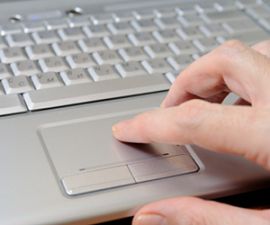Mastering Laptop Touchpads
Nancy Muir
Making the switch to a laptop? Meet your new mouse.
Posted April 9, 2010

Unlike a typewriter, which uses only a keyboard to enter text into documents, with a computer you use both a keyboard and a pointing device to enter text and give commands to the computer. Though you might have used a keyboard of some type before, or a traditional mouse attached to a desktop computer, a laptop pointing device, called a touchpad, might be new to you. Frankly, a laptop touchpad take a little getting used to.
Laptop mouses come in two types: the touchpad and the pointing stick. The touchpad by far the most common type, is a flat area, located beneath your keyboard. A pointing stick is a small button located among your computer’s keys. In effect, when you move your finger across the touchpad surface or place your finger on the pointing stick and move the stick slightly in any direction, a corresponding mouse pointer moves around your computer screen. With a touchpad, which I’ll focus on here because it is what you’re likely to have on your laptop, you perform clicking actions to open or select things on screen by using the right and left buttons on the bottom of the touchpad. The left button is used for left-click actions and the right button for right-click actions. Left clicking opens or selects items while right-clicking opens a shortcut menu from which you can choose commands to perform actions.
Here are the main functions of a touchpad and how to control them:
• Clicking: When people say “click,” they mean “press and release the left mouse button.” Clicking has a variety of uses. You can click while in a document to move the insertion point, a little line that indicates where your next action will take place. For example, you might click in front of a word you already typed and then type another word to appear before it in a letter. Clicking is also used in various windows to select check boxes or radio buttons (also called option buttons) to turn features on or off, or to select objects such as a picture or table in your document. Double-clicking can also be used to open objects for editing or to quickly select whole words.
• Right-clicking: If you click the right touchpad button, Windows displays a shortcut menu that is specific to the item you clicked. For example, if you right-click a picture, the menu that appears gives you options for working with the picture. If you right-click the Windows desktop, the menu that appears lets you choose commands that display a different view or change desktop properties.
• Clicking and dragging: To click and drag, you press and continue to hold down the left mouse button and then move (drag) the mouse to another location. For instance, you can press the left touchpad button (keeping it held down) and drag your finger on a touchpad up, down, right, or left to highlight contents of your document. This highlighted text is selected, meaning that any action you perform, such as pressing the Delete key on your keyboard or clicking a button for Bold formatting, is performed on the selected text.
• Scrolling: Many touchpads and wireless mouse models have a way to scroll through a document or Web site on your screen. Just roll the wheel on a mouse down to move through pages going forward, or scroll up to move backward in your document. With a touchpad, there is often an area marked on the right or left where you can run your finger up or down to scroll through a document.
If you’re used to a desktop computer mouse and can’t get the hang of the built-in mouse on your laptop, consider buying a portable wireless mouse. By plugging a small transmitter into a USB port on your laptop, you can use this more standard mouse to point, click, and drag, just as you do with a desktop computer.
Nancy Muir is the VP of Content and Curriculum for Look Both Ways, an Internet safety company (ilookbothways.com) and the author of over 50 books on computers and the Internet. Nancy has taught technical writing and Internet safety at the university level, holds a certificate in Distance Learning Design, and has been a senior manager in both the software and computer publishing industries.



Add A Comment
Want to leave a comment? Sign in.